THE ZOMBIE
The Bad Boy of Tiki Drinks
There are zombies and there are Zombies. We all know the zombie that Wikipedia calls “an animated corpse brought back to life by mystical means, such as witchcraft.” They’re a staple of horror flicks. That’s not what we’re talking about here.
We’re talking about the Zombie Cocktail. Wikipedia says it “was concocted to help a hung-over customer get through a business meeting” — but the customer returned a few days later complaining that the drink had turned him into “a zombie.”
Which wasn’t surprising. Because as originally mixed, this was one potent drink — so potent that its originator, Donn Beach (founder of the Don the Beachcomber restaurants) instituted a limit of two per customer.
Of course, that policy probably served as marketing hype, since it almost guaranteed that a fair number of customers would try to order more than their allotted quota of these bad boys. Given the popularity this drink achieved, it sounds like the marketing worked.
But what really worked was the taste. This is one outstanding cocktail — and its popularity is largely responsible for launching the Tiki craze.
By the way, you don’t have to worry about becoming a zombie when you drink a Zombie. There’s a less potent version that still retains the great taste of the original.
About Tiki Drinks, Their Ingredients, and Their Recipes
My Planter’s Punch and Mai Tai posts discussed a bit about Tiki history. As noted in those discussions, the Tiki concept was largely created by Donn Beach in the 1930s when he opened his first Don the Beachcomber restaurant.
But what exactly makes a Tiki drink distinctive? Well, they tend to use multiple rums, and often multiples of other ingredients (particularly fruit juices). Donn Beach often used a mix of rums to create flavors that no single rum possessed. So most of his recipes are fairly complex, and some require ingredients that aren’t easy to find.
The Zombie, for example, requires 151-proof rum — something most of us don’t have in our liquor cabinets. Moreover, it requires a 151 with a specific flavor found only in Demerara rum (which comes from the Demerara River region of Guyana). And not just any Demerara rum: We need something with a “gun powder” flavor. As far as I know, there is only one rum currently imported into the US with this specific flavor profile: Lemon Hart 151-proof Demerara rum. And it is hard to find (I provide a source in the Notes).
Difficult as it is to get the ingredients, an even bigger challenge is deciding which recipe to use. Trader Vic (the other great Tiki restaurateur) eventually got around to publishing most of his drink recipes, but Donn Beach never did. In fact, Beach was notoriously possessive and secretive about his cocktail recipes. Not only that, but he kept tinkering with them over the years. So some drinks — including the Zombie — may have more than half a dozen different “authentic” recipes, all created by Beach. And though Beach would never divulge his recipes, other bars naturally wanted to serve the drinks he made famous. So they started creating their own versions, some of which became more widely known than Beach’s.
Long story short: If you go looking for a Zombie recipe, you’ll find plenty — all of them different. What to do?
The most authoritative source for Tiki drink recipes is Jeff Berry, a/k/a Beach Bum Berry. His website has a wealth of information, and his books contain lots more (they’re great – I recommend them). Other Tiki sources are available, and I’ve made use of some. But an awful lot of what I know about Tiki drinks I learned from the “Bum.” So I turned to him when I wanted to figure out which of the many Zombie recipes were worth making. The two versions below are the answer I came up with.
Recipe: The Zombie
The Zombie, like many Tiki drinks, was originally served in a Tiki mug. Different establishments sourced these mugs, and often had specific mugs made for each of the most popular drinks. You can sometimes find old Tiki mugs at flea markets, yard sales, or antique stores. Or you can buy new ones at Amazon, where I got mine (one of which is pictured above). Otherwise, most of these drinks fit well in a tall 10- to 12-ounce glass.
The flavor of a Zombie is somewhat reminiscent of a Mai Tai, but with more layers and complexity. Having tasted several versions of the Zombie, I think the two best are Beach’s original recipe (which appears below as Version 1) and what might have been his last (it appears below as Version 2), which Beach developed specifically for Aku-Aku Restaurant in Las Vegas.
Version 1 has slightly better flavor. But this is the one that — for good reason — Beach limited to two per customer: Each drink contains the equivalent of almost 5 ounces of 80-proof spirits! That’s about as much as most of us will ever drink in an entire evening. Version 2, which is equivalent to almost 3 ounces of 80-proof spirits, is less potent (though it’s still a hefty drink), and its flavor is just a smidge less good than the original. I usually opt for the first version because I like it a bit more — but I split it with Mrs. Kitchen Riffs so we can both remain clear headed.
Both of these recipes are from Jeff Berry’s Beachbum Berry Remixed. They take about 5 minutes to mix, and are intended to serve 1 (but consume a whole one at your own risk). The Procedure for both is the same, so I only detail it for the first version.
Zombie Version 1 (the original)
Ingredients
- 1½ ounces Gold Puerto Rican rum (plain old Barcardi Gold is OK, though Barcardi 8 or Añejo might be better choices)
- 1½ ounces Jamaican amber rum (you want something with some age on it, like Appleton V/X)
- 1 ounce Lemon Hart 151-proof Demerara rum (unfortunately, there’s no substitute for this; see Notes)
- ¾ ounce lime juice
- ½ ounce falernum (see Notes)
- 2 teaspoons unsweetened white grapefruit juice (canned is OK; if you use pink, the color of the cocktail changes)
- 1 teaspoon cinnamon-infused simple syrup (see Notes for how to make)
- 1 teaspoon Homemade Grenadine (may substitute store bought)
- 1/8 teaspoon Pernod (or other absinthe-like liquor; you may find you prefer this drink made with a touch less)
- 1 - 2 dashes Angostura Bitters
- sprig of mint for garnish (optional but traditional; you can also garnish with a maraschino cherry, a pineapple wedge, a little umbrella — or whatever)
- Put all ingredients into a cocktail shaker half-filled with ice. Shake 20 - 30 seconds until well chilled.
- Strain into a tall (10- to 12-ounce) glass or Tiki mug filled with crushed ice.
- Garnish and serve.
- Alternate blender method: Put all ingredients into blender with ¾ cup crushed ice (measure this) and blend for 5 seconds, then pour into glass and garnish. See Notes.
Ingredients
- ¾ ounce dark Jamaican rum (I like Meyer’s; Goslings Black Seal suits my palate too, although it’s a Bermuda rum)
- ¾ ounce gold Puerto Rican Rum (plain old Barcardi Gold is OK, though Barcardi 8 or Añejo might be better choices)
- ¾ ounce Lemon Hart 151-proof Demerara rum (unfortunately, there’s no substitute for this; see Notes)
- ¾ ounce lime juice
- ¾ ounce unsweetened white grapefruit juice (canned is OK; if you use pink, the color of the cocktail changes)
- ¾ ounce cinnamon-infused simple syrup (see Notes for how to make)
- 1/8 teaspoon Pernod (or other absinthe-like liquor; you may find you prefer this drink made with a touch less)
- 1/8 teaspoon orange curacao (use Bols, or substitute Grand Mariner)
- 1/8 ounce falernum (see Notes)
- 1/8 ounce Homemade Grenadine (may substitute store bought)
- 1 - 2 dashes Angostura bitters
- same garnish as the first version
Notes
- The Zombie (like many Tiki drinks) derives its unique flavor in part from combining several different flavors and styles of rum. So it’s important to use the rums specified in the recipe.
- There is no easily obtainable alternative to Lemon Hart 151 Demarara rum. It has a wonderful flavor that works well when mixed in cocktails, although I find it way too harsh to drink by itself (because of the high alcoholic content). And it’s the flavor — not the alcoholic punch — that’s the reason for using it in this drink.
- Rum that is 151 proof (75% alcohol) is called “over proof.” You know those flaming drinks you sometimes see served in restaurants and bars? They’re probably lighting 151-proof rum (or maybe 151-proof vodka).
- Which brings us to an important safety point: This stuff is really flammable! Be careful with it around open flames.
- If your liquor store doesn’t stock Lemon Hart 151 — most don’t — you can order it online from Drink Up NY. These folks have a large selection of hard-to-find liquors, and charge reasonable shipping prices. Do note that when the delivery arrives, you’ll need to have someone over age 21 who’s available to sign for it. (By the way, I have no association with this company, other than being a satisfied customer.)
- You can find commercial cinnamon-infused simple syrup (Sonoma Syrup makes a good one), but it’s easy (and much cheaper) to make your own. Simply crush 3 sticks of cinnamon (sticks should be about 3 inches in length). Put crushed cinnamon sticks in a sauce pan with a cup of sugar and a cup of water. Bring to a simmer and stir to dissolve the sugar. Simmer for 2 or 3 minutes, then remove from the heat, and cover. Let sit for 2 or 3 hours before straining into a plastic squeeze bottle (or other container). Syrup should keep in the refrigerator for 4 or 5 weeks.
- In addition to being terrific in drinks that specify it, cinnamon-infused simple syrup makes a great flavoring for iced tea (or hot tea).
- As discussed in our post on Planter’s Punch, falernum is a ginger- and lime-flavored syrup. Fee Brothers makes a very good commercial one, and it’s stocked at many liquor stores. Otherwise Amazon carries it, although it’s pricy. If you don’t want to bother getting falernum, just add an equivalent amount of cinnamon-infused simple syrup.
- This recipe calls for just a few drops of Pernod, but a little Pernod goes a long way — it has a very distinctive and dominant flavor. If you find the taste overbearing, use a bit less next time you mix a Zombie. And if you just don’t like the flavor, leave it out. Omitting this may not be “correct,” but when it comes to drinks, your preferences trump “authentic.”
- Donn Beach developed a method of “flash blending” his drinks — blending for just a few seconds with crushed ice, then pouring the mix into a Tiki mug or tall glass. This not only chilled the drink but diluted it, making it more palatable to many people.
- I prefer to shake the drinks with ice, then strain into a glass filled with crushed ice (you can use cubed, too). The first sip or two will be a bit stronger than if you blend it, but as the crushed ice melts, it dilutes the drink.
- You’ll see some Zombie recipes that call for passion fruit syrup or extract. Beach did use these in his Zombies during the 1950s. But fresh passion fruit is expensive (about $2 per, and each one yields only a small amount of pulp) and it’s hard to find decent commercial passion fruit syrup. So although the versions with passion fruit are good, I’m ignoring them. But if you can find the syrup and see a recipe you like, have at it.
- In fact, I’ll give you the passion fruit syrup-containing recipe that you’re most likely to see (this is the standard Zombie recipe you find in many drinks books): 1 ounce gold Puerto Rican rum, 1 ounce white Puerto Rican Rum, 1 ounce 151-proof Demerara rum (Lemon Hart 151), 1 ounce unsweetened pineapple juice, 1 ounce lemon juice, 1 ounce lime juice, 1 ounce passion fruit syrup, 1 teaspoon brown sugar, 1 dash Angostura bitters.
Bad to the Bone
Mrs. Kitchen Riffs and I had a Zombie-fest a few weekends ago, taste-testing even more recipes than we discuss here. We took our own advice, as suggested in Cocktail Basics (the post that kicked off our Summer Sippin’ Series): We made one of each version and split it. That way we could test more drinks without getting blotto.
“So which do you prefer, Zombie Version 1 or Version 2?” I asked after we had narrowed our favorite recipes down.
“Tough choice! I think maybe the first version. Too bad that’s the one with so much booze in it.”
“Ditto. But the second version is pretty good too.”
And it is. In fact, if Version 1 didn’t exist, I’d be ecstatic about the taste of Version 2. Much of the flavor in both comes from the Lemon Hart 151-proof rum. This can be a pain to track down, but it adds a wonderful dimension. If you’re unsure about whether you’d like this drink enough to bother getting the necessary ingredients, try making a <a href=http://www.kitchenriffs.com/2011/07/mai-tai-cocktail.html>Mai Tai</a>. If you like that, you’ll definitely like the Zombie.
“Now that we’ve finished our testing,” said Mrs K R, “I think our Friday night cocktail next week should be Zombies again. They’re delish.”
“Sure,” I agreed. “I’ll never turn down a Zombie. Version 1?”
“Of course. But this time a whole one, apiece.”
“Are you sure you can handle one of these bruisers all by yourself?” I asked.
“Yes, because I’m bad,” she batted her eyelashes, “bad to the bone.”
~kitchenriffs.com

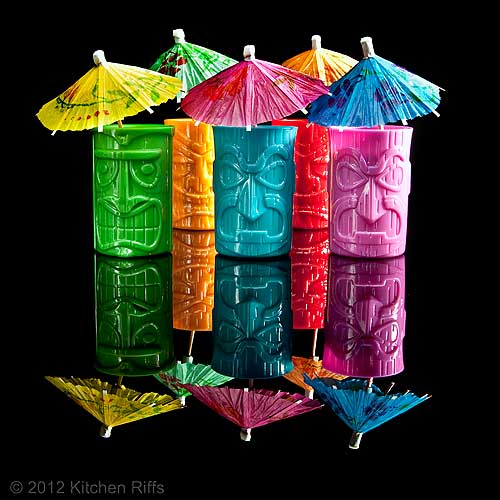
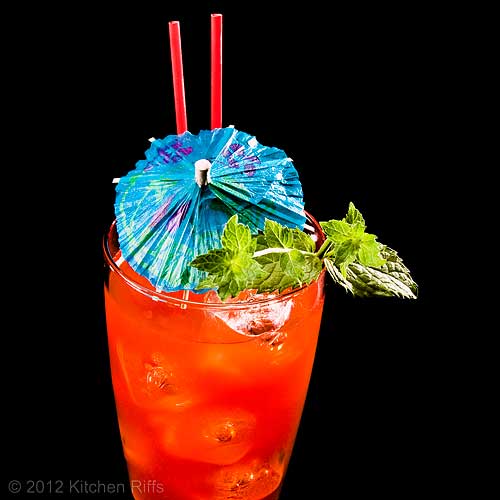
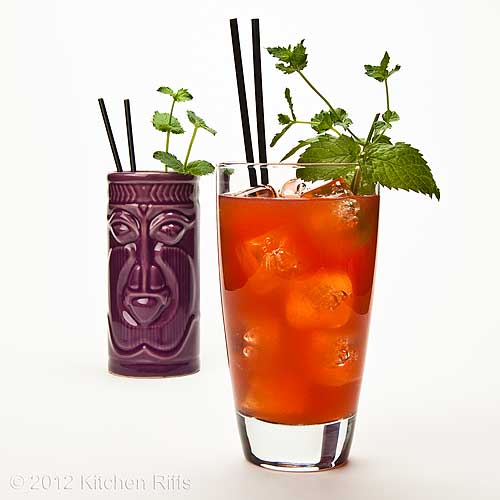
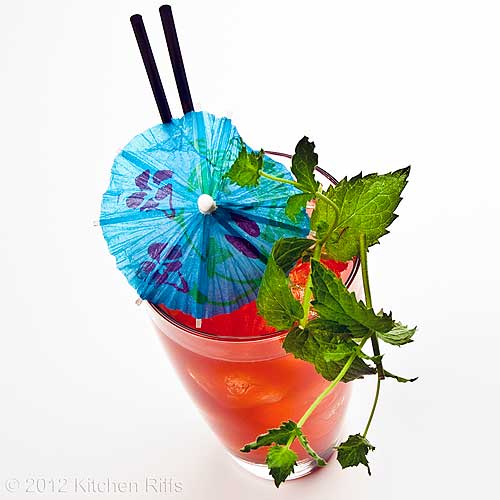
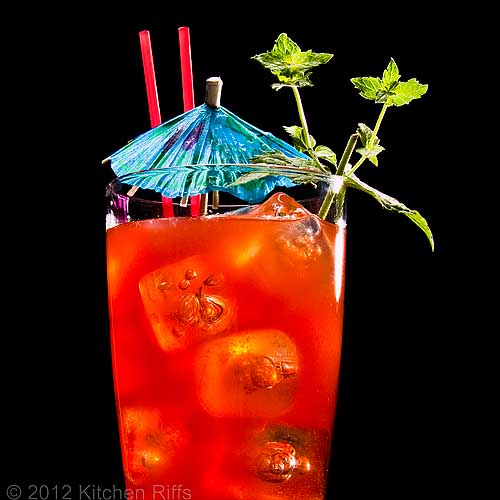
No comments:
Post a Comment